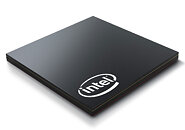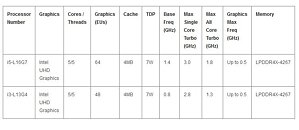Wednesday, June 10th 2020

Intel Launches Lakefield Hybrid Processors: Uncompromised PC Experiences for Innovative Form-Factors
Today, Intel launched Intel Core processors with Intel Hybrid Technology, code-named "Lakefield." Leveraging Intel's Foveros 3D packaging technology and featuring a hybrid CPU architecture for power and performance scalability, Lakefield processors are the smallest to deliver Intel Core performance and full Windows compatibility across productivity and content creation experiences for ultra-light and innovative form factors.
"Intel Core processors with Intel Hybrid Technology are the touchstone of Intel's vision for advancing the PC industry by taking an experience-based approach to designing silicon with a unique combination of architectures and IPs. Combined with Intel's deepened co-engineering with our partners, these processors unlock the potential for innovative device categories of the future," said Chris Walker, Intel corporate vice president and general manager of Mobile Client Platforms.Intel Core processors with Intel Hybrid Technology deliver full Windows 10 application compatibility in up to a 56% smaller package area for up to 47% smaller board size and extended battery life, providing OEMs more flexibility in form factor design across single, dual and foldable screen devices while delivering the PC experiences people expect. They are also:
Intel Core i5 and i3 processors with Intel Hybrid Technology leverage a 10 nm Sunny Cove core to take on more intense workloads and foreground applications, while four power-efficient Tremont cores balance power and performance optimization for background tasks. The processors are fully compatible with 32- and 64-bit Windows applications, helping reach new heights for the thinnest and lightest designs.
"Intel Core processors with Intel Hybrid Technology are the touchstone of Intel's vision for advancing the PC industry by taking an experience-based approach to designing silicon with a unique combination of architectures and IPs. Combined with Intel's deepened co-engineering with our partners, these processors unlock the potential for innovative device categories of the future," said Chris Walker, Intel corporate vice president and general manager of Mobile Client Platforms.Intel Core processors with Intel Hybrid Technology deliver full Windows 10 application compatibility in up to a 56% smaller package area for up to 47% smaller board size and extended battery life, providing OEMs more flexibility in form factor design across single, dual and foldable screen devices while delivering the PC experiences people expect. They are also:
- The first Intel Core processors shipping with attached package-on-package (PoP) memory, further reducing board size.
- The first Intel Core processors to deliver as low as 2.5 mW of standby SoC power - an up to 91% reduction compared to Y-series processors - for more time between charges.
- The first Intel processors to feature native dual internal display pipes, making them ideally suited for foldable and dual-screen PCs.
Intel Core i5 and i3 processors with Intel Hybrid Technology leverage a 10 nm Sunny Cove core to take on more intense workloads and foreground applications, while four power-efficient Tremont cores balance power and performance optimization for background tasks. The processors are fully compatible with 32- and 64-bit Windows applications, helping reach new heights for the thinnest and lightest designs.
- Smallest package size, enabled by Foveros: With Foveros 3D stacking technology, processors achieve a dramatic reduction in package area - now only a miniscule 12x12x1 mm, approximately the size of a dime - by stacking two logic dies and two layers of DRAM in three dimensions, also eliminating the need for external memory.
- Hardware-guided OS scheduling: Enabling real-time communication between the CPU and the OS scheduler to run the right apps on the right cores, the hybrid CPU architecture helps deliver up to 24% better performance per SOC power and up to 12% faster single-threaded integer compute-intensive application performance.
- More than 2x throughput on Intel UHD for AI-enhanced workloads: Flexible GPU engine compute enables sustained, high-throughput inference applications - including AI-enhanced video stylization, analytics and image resolution upscaling.
- Up to 1.7x better graphics performance: Gen11 graphics delivers seamless media and content creation on the go - the biggest leap in graphics for Intel processor-based 7-watt systems. Convert video clips up to 54% faster, and with support for up to four external 4K displays, immerse in rich visuals for content creation and entertainment.
- Gigabit connectivity: With support for Intel Wi-Fi 6 (Gig+) and Intel LTE solutions, experience seamless video conferencing and streaming online.


33 Comments on Intel Launches Lakefield Hybrid Processors: Uncompromised PC Experiences for Innovative Form-Factors
browser.geekbench.com/processors/1798
Personally I think its an interesting new CPU, which should be a good fit for very lightweight fanless laptops for business travel and such.
Example: news.samsung.com/global/experience-the-next-level-of-mobile-computing-with-galaxy-book-s
This has no chance IMHO , both Apple and Arm and even Qualcomm will have competing parts with lower power small cores and at least 2 high power cores, and software has gone multithreaded now, it is too late in the day for a single high-performance core to be viable across a wide range of typical use cases IMHO
If only as their initial salvo into further miniaturization and revised processor packaging it sounds like something that should evolve into good things for them and us eventually. Consider Intel eventually die-shrinking something like the "comet-lake" laptop chip as the 'main processor' in something like this with the addition of a couple minor smaller cores. On the speeds, and comparable power I would counter that this is their version 1.0 product for this process. Not sure how many people reading this remember but USB v1.0 (which we used to call plug-n-pray) sucked too...but look at it now.